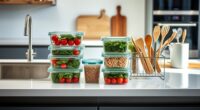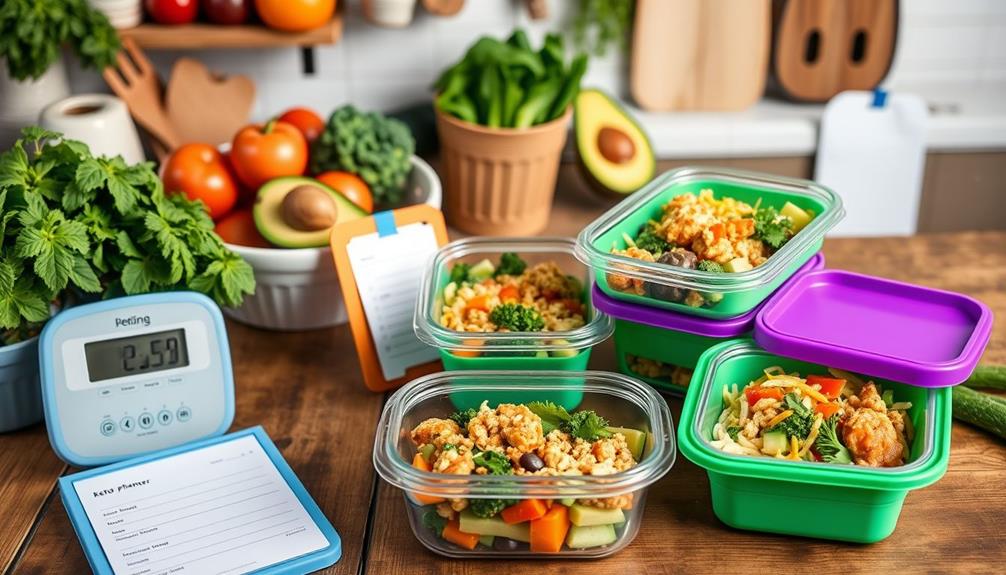To maximize fridge and freezer space for meal prep, group similar items in clear, labeled containers to see everything at a glance. Use stackable bins and vacuum-sealed bags to save space, and adjust shelves to create designated zones for different foods. Regularly remove expired items and maintain good airflow to keep everything fresh. Organizing effectively not only frees up space but also guarantees food safety—continue exploring tips to optimize your storage even further.
Key Takeaways
- Use stackable, airtight containers and vacuum-sealed bags to maximize vertical space and preserve freshness.
- Organize items by food groups with clear labels and prioritize older products at the front.
- Adjust shelf heights and create designated zones for different meal prep ingredients.
- Regularly check and remove expired or spoiled items to free up space and prevent clutter.
- Maintain proper air circulation by avoiding overfilling and leaving space around items for consistent temperatures.

Are you struggling to fit everything into your fridge and freezer? Overcrowding can make it tough to find what you need quickly, and it can even compromise food safety. When your fridge is packed, air can’t circulate properly, which can lead to uneven cooling and increased spoilage risks. To maximize space and keep your food fresh, you need effective organization tips that prioritize safety and efficiency.
Start by grouping similar items together—place all dairy in one section, meats in another, and leftovers in clear containers. Clear containers not only help you see what’s inside at a glance but also prevent unnecessary opening of multiple packages, helping maintain consistent temperatures. Label everything with dates so you can easily identify what needs to be used first, reducing waste and safeguarding food safety. When stacking items, position the oldest products toward the front, so you use them before they spoil.
Group similar items, use clear containers, label with dates, and prioritize older products to reduce waste and enhance freshness.
Using stackable storage bins can dramatically improve organization. These bins optimize vertical space in both your fridge and freezer, allowing you to store more without creating clutter. Make sure to choose containers that are airtight; this keeps food fresh longer and prevents cross-contamination. For your freezer, consider investing in vacuum-sealed bags for meats and bulk produce. Removing excess air from packaging not only saves space but also reduces freezer burn, preserving quality and safety.
Adjust your shelves to fit your needs, creating designated zones for different food groups. This prevents overcrowding and makes it easier to access what you need without disturbing everything else. Don’t forget about the door compartments—they’re ideal for condiments and small items but aren’t suitable for perishables that require consistent cold temperatures. Keep those in the main compartments to safeguard food safety. Additionally, proper air circulation within your appliance is essential to maintain uniform temperatures and prevent spoilage.
Regularly check your fridge and freezer for expired or spoiled items. Clearing out old food creates more space and reduces the risk of contamination. Incorporating space-saving storage solutions can further improve organization and efficiency. Proper air circulation within your appliance is essential to maintain uniform temperatures and prevent spoilage. To further enhance your organization, consider the benefits of temperature control systems that help maintain ideal conditions for different types of food. Using efficient storage solutions not only maximizes space but also extends the freshness of your food. When you organize your space, make a habit of doing quick weekly audits to keep things tidy and safe. Also, avoid overfilling your fridge; leaving some room for air circulation helps maintain proper temperatures, which is essential for food safety.
Frequently Asked Questions
How Often Should I Defrost My Freezer for Optimal Storage?
You should defrost your freezer at least once a year for ideal storage and efficient freezer maintenance. If you notice a buildup of more than a quarter-inch of ice, it’s time to defrost sooner. Regular defrosting helps prevent frost buildup, saves energy, and keeps your food fresh. Stick to a consistent defrosting schedule, and you’ll maintain a well-functioning freezer that maximizes space and keeps your meal prep organized.
What Are the Best Containers for Stacking in the Fridge?
Ever wondered how to keep your fridge organized and maximize space? Stacking containers are your best bet, especially if you choose airtight options. They save space, prevent spills, and keep food fresh longer. Look for stackable, BPA-free plastic or glass containers with secure lids. Do you want easy access and a tidy fridge? Then prioritize containers that nest securely and fit comfortably in your fridge, making meal prep simpler and more efficient.
How Can I Prevent Cross-Contamination Between Stored Foods?
To prevent cross-contamination between stored foods, you should focus on proper food labeling and air circulation. Always label containers with contents and dates, so you know what’s inside and handle them accordingly. Keep raw meats on the bottom shelf to avoid drips, and make certain of good air circulation by not overstuffing your fridge. This helps maintain a clean environment and reduces the risk of bacteria transfer between foods.
Are There Specific Foods That Spoil Faster in the Freezer?
Imagine you freeze fresh berries only to find they’re mushy months later. Some foods, like berries and leafy greens, spoil faster in the freezer due to high moisture content. For ideal food preservation and freezer organization, use airtight containers and label everything. These practices prevent freezer burn and extend shelf life, ensuring your meals stay fresh and safe longer. Yes, some foods just don’t hold up well in prolonged freezing!
What Is the Ideal Temperature Setting for Maximum Storage Efficiency?
You should set your freezer to 0°F (-18°C) for ideal temperature control and energy efficiency. This temperature keeps your food frozen solid, preventing spoilage and bacteria growth. Maintaining this setting ensures your freezer works efficiently without wasting energy. Regularly check the temperature with a thermometer, especially if you notice uneven cooling, so you maximize storage space and keep your meal prep ingredients fresh and safe.
Conclusion
With a little organization, you can maximize your fridge and freezer space without sacrificing freshness or convenience. Some might think it’s too much effort, but the payoff is worth it—more room for meal prep and less stress. Regularly rotate and discard expired items, and you’ll find it’s easier to keep everything tidy and accessible. Ultimately, a well-organized space saves you time, money, and frustration in the long run.









